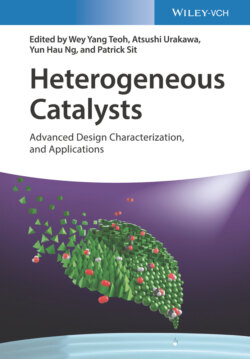Читать книгу Heterogeneous Catalysts - Группа авторов - Страница 49
4.2.2.2 Graphene Oxide as Precursor of Graphene‐Supported Catalyst
ОглавлениеThis method is derived from the preparation described in Section 4.2.1, but the reduction is stronger and leads to the simultaneous reduction of both the metal precursor and GO. This is the most commonly used method to prepare metal/graphene catalysts due to the strong interactions of GO with the metal precursor and the possibility of carrying out impregnation in aqueous phase. A composite based on metal ions and GO is prepared first, followed by a harsh reduction treatment using a reducing agent either in liquid or gas phase. The final product consists of metal nanoparticles on rGO. When the reduction is carried out in liquid phase, nucleation and reduction of the metal take place simultaneously. This is the case of solvothermal reduction in liquid phase at moderate temperatures. Generally, the mixture of GO, metal precursor, and reducing agent (e.g., hydrazine, ethylene glycol, NaBH4) is heated (100–150 °C) by conventional heating or microwave, leading to the simultaneous reduction of GO that becomes rGO, resulting in a metal supported on graphene material. The simultaneous reduction of GO and metal in solution usually leads to a broad metal distribution or to relatively large nanoparticles (50–100 nm).
The reduction can also be carried out in gas phase (e.g., H2 gas) after drying the pre‐impregnated metal precursor on GO. The method involves several steps of impregnation, drying, and reduction, leading to nanometric particles, i.e. Pd and Pt nanoparticles of around 2 nm, whereas the size of Ni and Mn nanoparticles is between 4 and 6 nm [13]. The first step is the intercalation of a chosen metal salt into GO via impregnation, forming the metal salt anchored on GO oxygenated groups. In the second step, this composite undergoes an explosive reaction or “popping” at around 200 °C, leading to the formation of large‐surface‐area graphene with well‐dispersed, partially decomposed metal precursors strongly anchored on the graphene sheets.
A special case is the preparation of catalyst nanoparticles on 3D macrostructures consisting of 2D graphene nanosheets with a foam‐like structure, namely, graphene aerogels. When GO is reduced under solvothermal mild conditions, the graphene nanosheets self‐assemble into 3D hydrogels, which can be dried subsequently by freeze‐drying or supercritical CO2 to produce graphene aerogels [14]. These 3D structures are favorable as structured catalytic reactors due to the ease in handling and separation. It is very interesting that the formation of both metal nanoparticles and the graphene aerogel support can take place in a one‐pot solvothermal synthesis using hot water as a mild reducing agent. The addition of divalent and trivalent ions (e.g. Ca2+, Mg2+, Cu2+, Pb2+, Cr3+, Fe3+) in GO dispersion promotes the formation of GO hydrogels [15]. Fe2+ ions are anchored onto the oxygenated functional groups of GO and hydrolyzed at acid pH to give Fe oxide nanorods (60 nm) or precipitated as oxide nanoparticles (30 nm) at basic pH [16]. By adding a reducing agent, 10 nm Fe oxide nanoparticles wrapped by graphene aerogels could be prepared [17]. By using also the one‐pot hydrothermal reduction method but adding some mild reductants such as sodium citrate and sodium acetate, the size of Fe3O4 clusters was reduced to 5 nm on graphene aerogel [18]. Adding ascorbic acid as reductant and 100 °C solvothermal treatment, 5–13 nm noble metal nanoparticles have been prepared on graphene aerogels[19]. Instead of using aqueous dispersion of GO, a GO dispersion in ethylene glycol and subsequent hydrothermal method was used to prepare 4–6 nm Ru nanoparticles on graphene aerogel [20]. It is possible to decouple the formation of the rGO hydrogel and the deposition of the metal using a two‐step approach. By capitalizing on the advantage of high water content within the rGO hydrogel, an aqueous solution of the metal is infiltrated into the hydrogel. This approach has been used to introduce MoS2 in the hydrogel, which is subsequently freeze‐dried [21].
